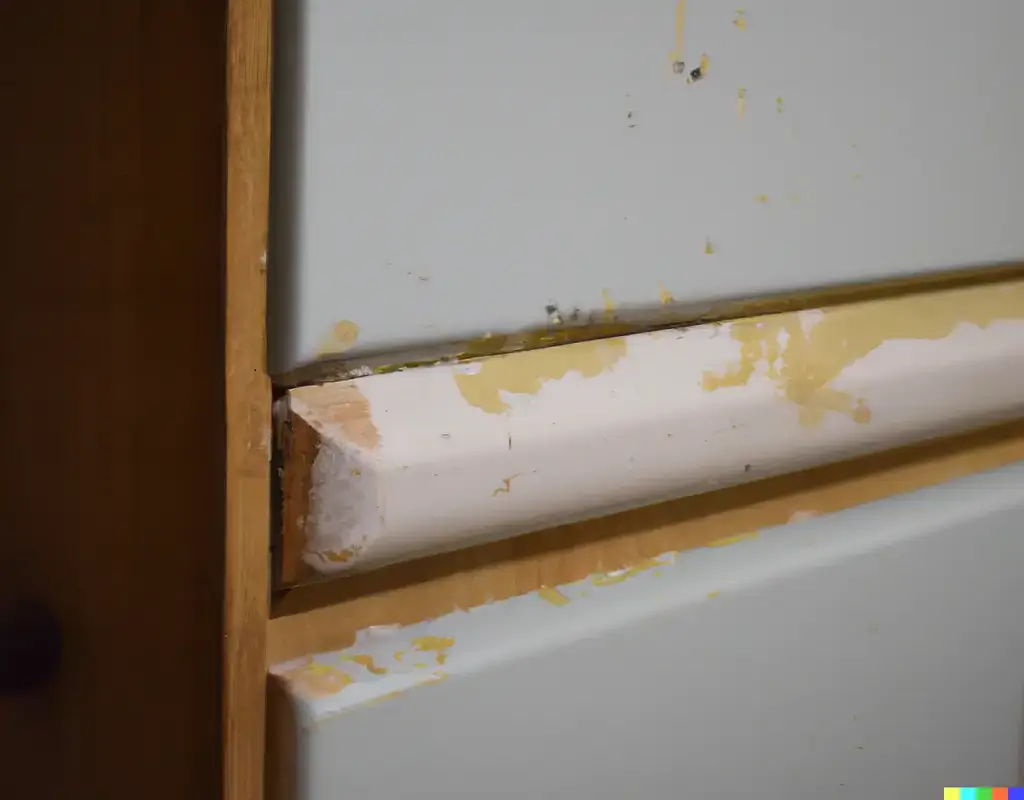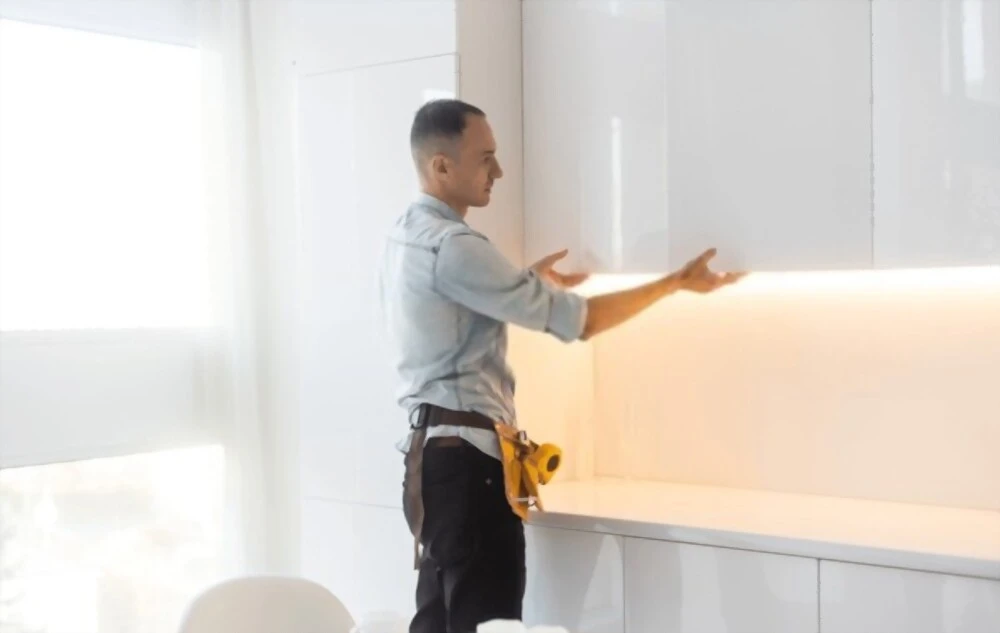
Proper preparation and maintenance of your cabinets are key to keep cabinet paint from chipping. With the proper care, you can keep your painted cabinets looking new for years.
When it comes to painting cabinets, the biggest fear for most homeowners is that the paint will start chipping and peeling. Stopping cabinet paint from chipping is a massive headache, especially if you’ve just spent hours or days painting your cabinets.
In this article, we’ll outline reasons why your cabinet paint is chipping, types of paints, and tips for preventing cabinet paints from chipping.
Why Is My Cabinet Paint Chipping?
Before we get into how to prevent paint from chipping, it’s essential to understand why it happens in the first place.
Here are some common reasons why your cabinet paint is chipping:
Inadequate preparation before painting
One of the leading causes of chipped paint is a need for adequate preparation before painting.
If you don’t sand, clean, and prime the surface of your cabinets before painting, it’s more likely that the paint will not adhere properly and start to chip off.
Lack of primer
Another common mistake homeowners make is skipping the primer. Primer helps to create a bond between the paint and the surface of your cabinets.
This will help to prevent the paint from chipping.
Poor adhesion
If the paint doesn’t adhere properly to your cabinets, it’s much more likely to chip and peel. To help ensure good adhesion, make sure to use a paint formulated for cabinets (such as an oil-based enamel).
And make sure the surface is thoroughly sanded before painting.
Not giving enough drying and curing time
When you paint cabinets, it’s essential to give the paint enough time to dry and cure. If you don’t give the paint adequate drying and curing time, it won’t have enough time to properly set and could start chipping.
Most paints should be given at least 24 hours before they’re ready for use.
Poor Maintenance
Poor maintenance can also lead to chipped paint. Make sure to clean your cabinets regularly.
If possible, use a mild detergent or soap to avoid damaging the paint. Additionally, you should avoid using harsh abrasives or chemicals, which can weaken the paint and cause it to chip or peel.
Use Of Poor Quality Paint
Using poor-quality paint can also make your cabinet paint more susceptible to chipping. Make sure to use good quality, durable paint designed for cabinets.
Incorrect application technique
Applying paint in thick, uneven layers can cause it to chip. It’s important to apply paint in thin, even coats to ensure proper adhesion.
Environmental factors
Exposure to moisture, extreme temperatures, and high humidity can cause paint to chip. Make sure to paint in a well-ventilated area and avoid painting in extreme weather conditions.
Poor quality of the wood
If the wood of the cabinet is of poor quality it will be difficult to paint it and make the paint stick properly. It will be more prone to chipping and peeling.
High traffic areas
Cabinets in high-traffic areas will be more likely to chip, as they will be subject to more wear and tear.
Lack of protection
Not applying a clear coat or sealant over the paint will make it more susceptible to chipping.
Here are some tips that can help identify the cause of chipping paint on your cabinets:
1. Check the preparation: Are your cabinets adequately sanded and primed before you paint them?
2. Check for signs of improper adhesion: Are there any areas on your cabinets where the paint is starting to peel?
3. Check for signs of moisture: Is there any condensation or water damage to the paint?
4. Check for signs of poor maintenance: Are there any areas where the paint is starting to chip or peel?
Creating a checklist with the points mentioned above is essential to avoid facing chipping cabinets again.
Choosing the Right Paint and Surface Preparation
Choosing the right type of paint and proper surface preparation are essential for preventing chipping of cabinet paints.
Here are the different types of paints available in the market:
Oil Based Paints
Oil-based paints are the most durable and provide the best protection against chipping. However, they require more preparation and curing time before use, so planning is essential.
Oil-based enamels are one of the best options for painting cabinets and provide excellent protection against chipping and peeling.
Water-based paints
Water-based paints are easier to clean up and dry quickly. However, they don’t provide the same protection against chipping as oil-based paints.
Therefore, it’s essential to use quality water-based paint and ensure the surface is adequately prepared before painting.
Acrylic paints
Acrylic paints provide a glossy finish that can help make cabinets look beautiful. However, they are more durable than water-based paints.
Even while using acrylic paints it’s important that the surface is properly prepared.
When it comes to surface preparation, clean the cabinets and sand them with fine-grit sandpaper before painting to ensure good adhesion. The next step is to degrease the cabinets with a degreasing cleaner and then apply a primer before painting.
Finally, it’s essential to ensure the paint is thoroughly dry and cured before using the cabinets.
For paint brands and products that are suitable for cabinets and have good chipping resistance, we recommend using water-based paints like Sherwin Williams ProClassic Interior Acrylic Latex Enamel, Benjamin Moore Advance Interior Satin Paint, or Rust-Oleum Cabinet Transformations for a smooth, durable finish.
Adhesion and Painting Techniques to Keep Cabinet Paint from Chipping
Achieving a smooth and long-lasting paint finish on your cabinets requires proper adhesion and painting techniques. In this subtopic, we will explore the role of adhesion and primer in preventing chipping, and provide tips for using the right tools and techniques to achieve a flawless finish.
The Role of Adhesion and the Importance of Primer
Once you have chosen the right paint and prepared the surface, it’s essential to apply the paint properly.
Adhesion plays a vital role in preventing chipping on cabinet paint. Adhesion is when the paint sticks firmly to a surface and forms a lasting bond.
Good adhesion between the paint and the surface will help protect against chipping, especially regarding cabinets.
Primer is also essential for preventing chipping, providing an extra layer of protection between the surface and the paint. Primer helps to ensure better adhesion between the paint and the surface, which helps protect against chipping.
Furthermore, primer can also help fill small cracks and crevices in the surface, further preventing chips and cracks in the paint.
Using a quality primer when painting cabinets is essential, as it can help ensure that the paint job lasts for years to come.
Tools and Techniques for a Smooth Cabinet Paint Coverage
Using the right brush or roller and paint sprayers are essential for achieving a professional, smooth finish on cabinets. Different painting tools can provide various looks and textures, so choosing the right tool for the job is vital.
When using a brush or roller, make sure to use the correct type so that there are no streaks or brush strokes in the finish. A good-quality brush with synthetic bristles and a roller with a 3/8″ nap are best.
Paint sprayers are also an excellent option for painting cabinets, as they provide an even finish quickly and easily. However, it’s essential to use a high-quality sprayer for the best results.
Finally, make sure to allow adequate drying and curing times. Different types of paint require additional drying and curing times, so it’s essential to read the instructions on the paint label.
For example, oil-based paints may take up to 24 hours to dry and several days to cure, while water-based paints usually require only a few hours to dry and 1-2 days to cure.
Tips for Cabinet Paint Drying and Curing for a Flawless Finish
It’s essential to adhere to the drying and curing times, as this is the only way to ensure the paint job will last.
1. Start with a clean surface: Before painting, clean the cabinets and remove any dirt or grease that could prevent the paint from adhering correctly.
2. Sand the surface: Use fine-grit sandpaper to lightly sand the cabinets and create an even surface for the primer and paint.
3. Apply a degreasing cleaner: Use a degreaser to remove any remaining grease from the cabinets before applying primer.
4. Apply a primer: Primer provides an extra layer of protection between the surface and the paint and helps to ensure adhesion. Make sure to always use a quality primer when painting cabinets.
5. Choose the right brush or roller: When using a brush or roller, make sure to use the correct type so that there are no streaks or brush strokes in the finish. A good-quality brush with synthetic bristles and a roller with a 3/8″ nap are best.
6. Paint in one direction: To help ensure a smooth, even finish, paint in one direction and don’t “zig-zag” the brush or roller.
7. Add an extra coat: For added protection, apply a second coat of paint. Make sure the first coat of paint has dried first.
8. Allow adequate drying and curing times: Different types of paint require different drying and curing times, so it’s essential to read the instructions on the paint label.
For example, oil-based paints may take up to 24 hours to dry and several days to cure, while water-based paints usually require only a few hours to dry and 1-2 days to cure.
9. Seal the paint: After allowing the paint to dry and cure, seal it with a quality sealant to help protect it from moisture, dirt, and other damage.
10. Clean your painting tools: Always clean brushes and rollers with soap and water after use to ensure they last for future painting projects.
These tips and techniques should help ensure a professional, smooth finish on cabinets. With the correct tools and techniques, you can achieve a beautiful paint job that will last for years!
Protection and Maintenance in Preventing Chipped Cabinet Paint
Once you have finished painting the cabinets, it’s essential to protect and maintain them properly.
Proper care and maintenance are essential for preventing chipping on cabinet paint. Regularly dusting, cleaning, and polishing cabinets will help to prevent dirt and dust from settling into the paint, which can cause it to chip.
Avoiding abrasive cleaners and scrubbing too hard when cleaning is also essential to prevent paint damage.
Waxing or using a sealant can also help protect the cabinets. It creates an extra layer of protection that prevents dirt and dust from collecting on the paint.
Additionally, avoiding harsh chemicals or abrasives when cleaning cabinets is essential, as these can cause the paint to chip. Proper care and maintenance will keep cabinets looking smooth and shiny for years.
Here is what you need to do to prevent chipping cabinets:
Cleaning
To keep your cabinets pristine, they should be dusted regularly with a microfiber cloth. Use mild soap and warm water for deeper cleaning to avoid damaging the paint.
Make sure to rinse off all of the soap thoroughly with clean water and dry with a soft cloth.
Protection from scratches and dings
To protect your cabinets from scratches and dings, you can apply a clear wax or sealant. This will create an extra layer of protection that prevents dirt and dust from settling into the paint, which can cause it to chip.
Additionally, avoiding harsh chemicals or abrasives when cleaning cabinets is essential, as these can cause the paint to chip.
Avoiding temperature and humidity changes
To help prevent paint from cracking or peeling, it’s important to avoid drastic changes in temperature and humidity.
Keep the area around the cabinets relatively cool and dry to ensure a long-lasting finish.
Special Techniques and Products
In addition to the basic painting techniques, some special techniques and products can help you achieve a professional finish on your cabinets.
Using a paint sealer or surface conditioner
Before painting, it’s essential to use a quality sealer or surface conditioner to prevent the paint from chipping and flaking.
This product helps form a protective layer that stops dirt and dust from settling into the paint, which can cause it to chip.
Using specialty primers
Specialty primers are designed to provide extra adhesion and protection on difficult surfaces such as cabinets.
These primers can help prevent the paint from chipping and flaking while providing extra protection against scratches and dings.
Adding paint additives
Adding a specialty additive to the paint can help to further protect the cabinets from chipping and flaking.
These additives form a protective barrier that prevents dirt and dust from settling into the paint, which can cause it to chip.
Additionally, the additives can help make the paint last longer, providing extra protection against scratches and dings.
Using lacquer or varnish
Applying a clear lacquer or varnish over the painted surface can help to further protect cabinets from chipping and flaking.
This product provides an extra layer of protection that prevents dirt and dust from settling into the paint, which can cause it to chip.
Using a paint sprayer is an efficient and effective way to paint cabinets. Paint sprayers provide a smooth, even finish that isn’t easy to achieve with a brush or roller.
Additionally, they offer a more efficient and cost-effective solution than traditional painting methods.
When using a paint sprayer, there are some critical best practices to follow:
- Start by prepping the surface. Make sure to remove any dirt or debris from the surface before painting.
- Use a high-quality paint sprayer and make sure it’s properly cleaned and maintained.
- Use a primer before applying the paint to ensure that the finish will adhere properly.
- Use a light, even stroke, when spraying the paint onto the surface.
- Move your hand in a back-and-forth motion, and keep the sprayer approximately 12 inches from the surface.
- Allow adequate drying time between coats of paint and apply additional coats until the desired finish is achieved.
- Finally, clean the paint sprayer thoroughly after each use.
Following these tips will help ensure that you get the best results when painting cabinets with a paint sprayer.
Conclusion
Painting cabinets can be tedious and challenging, but you can achieve beautiful results with the right techniques and products.
Be sure to properly prep the surface, use quality paint and materials, avoid drastic changes in temperature or humidity, and follow best practices when using a paint sprayer for an efficient and even finish.
With these essential tips in mind, you can create stunning cabinets that will last for years.
Good luck with your cabinet painting project!


